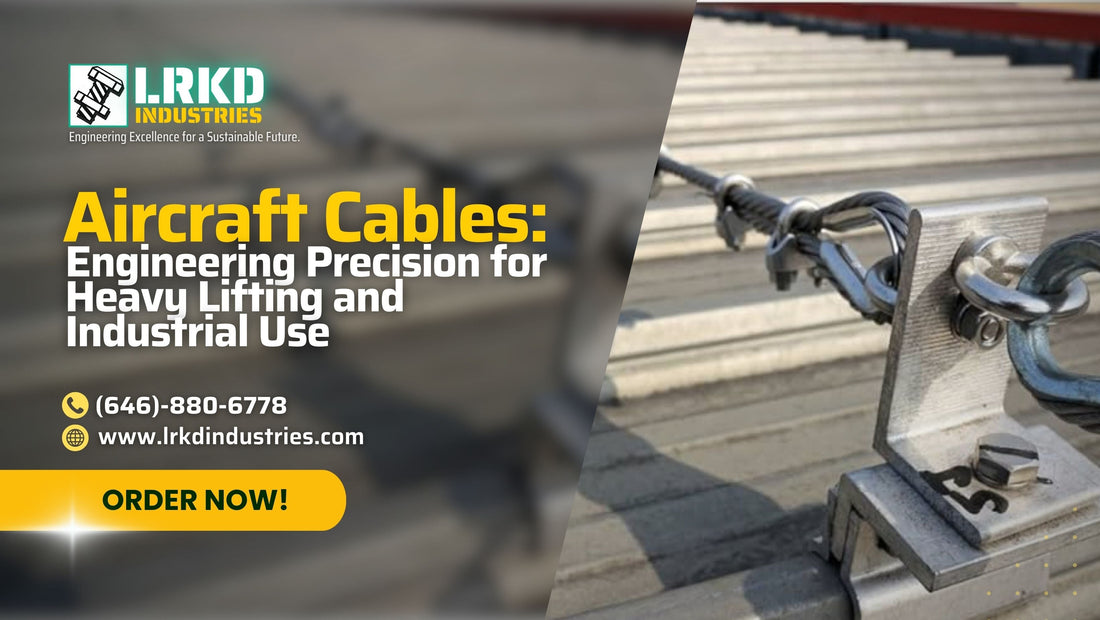The Backbone of Heavy-Duty Engineering
Picture this: A massive cargo plane prepares for takeoff, heavy containers secured inside. A construction crane hoists steel beams high above a bustling cityscape. A rescue helicopter lifts stranded hikers from a rugged mountain pass. What do all these high-stakes operations have in common? Aircraft cables.
Aircraft cables are the unsung heroes behind countless heavy-lifting and industrial applications. Designed for strength, flexibility, and durability, they ensure safety and efficiency in aerospace, construction, maritime, and manufacturing sectors. But what makes these cables so reliable, and how do they compare to other wire rope solutions? Let’s dive deep into the world of aircraft cables and explore their specifications, uses, and load capacities.
What Are Aircraft Cables?
Aircraft cables, also known as steel wire ropes, are high-strength, multi-strand cables made primarily of galvanized steel or stainless steel. Originally developed for aviation applications, they are now widely used across industries that demand extreme strength and reliability.
Key Features of Aircraft Cables:
High tensile strength – Can withstand extreme loads without snapping.
Flexible yet durable – Designed to endure repeated bending and tension.
Corrosion-resistant – Stainless steel variants resist rust in harsh environments.
Lightweight yet powerful – Provides optimal strength without adding unnecessary weight.
|
Feature |
Benefit |
|
High tensile strength |
Prevents failure under extreme loads |
|
Corrosion resistance |
Extends cable lifespan in harsh environments |
|
Flexibility |
Adapts to complex movements and pulleys |
|
Lightweight |
Reduces overall system weight |
Applications of Aircraft Cables in Industry
Aircraft cables are not just for airplanes. They play a critical role in industries where precision and safety are non-negotiable.
Aerospace and Aviation
Used in flight control systems, landing gear, and securing cargo.
Designed to meet FAA and military-grade standards.
Construction and Heavy Lifting
Essential in tower cranes, elevators, and hoisting mechanisms.
Provides structural support for suspension bridges.
Marine and Offshore Operations
Used in ship rigging, winches, and mooring lines.
Stainless steel cables prevent rust from saltwater exposure.
Manufacturing and Industrial Machinery
Integral to conveyor belts, robotic arms, and automated machinery.
Ensures smooth and safe operation in factories and warehouses.
|
Application Sector |
Common Use Cases |
|
Aerospace |
Flight control, cargo handling |
|
Construction |
Cranes, elevators, suspension bridges |
|
Marine & Offshore |
Rigging, mooring, winches |
|
Manufacturing & Industry |
Conveyor belts, robotic arms |
Specifications: Strength and Load Capacities
Aircraft cables are manufactured to strict specifications to meet safety and performance requirements. Here’s a breakdown of popular aircraft cable sizes, materials, and load capacities:
Common Aircraft Cable Sizes and Load Ratings
|
Cable Diameter (inches) |
Minimum Break Strength (lbs) |
Core Type |
|
1/16" |
480 |
7x7 |
|
3/32" |
920 |
7x7 |
|
1/8" |
2,000 |
7x19 |
|
3/16" |
4,200 |
7x19 |
|
1/4" |
7,000 |
7x19 |
|
3/8" |
14,400 |
7x19 |
Galvanized Steel vs. Stainless Steel: Which One to Choose?
Galvanized Steel Aircraft Cables
More affordable
Offers good corrosion resistance
Best for indoor and moderate outdoor conditions
Stainless Steel Aircraft Cables
Superior corrosion resistance (ideal for marine & harsh environments)
Higher cost but longer lifespan
Ideal for aerospace, medical, and food processing industries
Choosing the Right Aircraft Cable for Your Needs
When selecting an aircraft cable, consider the following factors:
✅ Load Requirements – Ensure the cable meets or exceeds the load rating for your application.
✅ Material – Opt for stainless steel if corrosion resistance is critical.
✅ Flexibility – Choose a 7x19 strand construction for higher flexibility.
✅ Environmental Conditions – Exposure to moisture, chemicals, or saltwater requires stainless steel.
✅ Certifications – Look for FAA, MIL-SPEC, or ASTM standards where applicable.
Conclusion: The Power of Precision Engineering
From aerospace to construction, aircraft cables prove that engineering precision saves lives and ensures efficiency in heavy-lifting operations. Whether you need them for industrial hoisting, flight control, or marine applications, selecting the right size, material, and load rating is crucial for safety and performance.
Are you looking for top-quality aircraft cables for your next project? At LRKD Industries, we provide high-performance cables designed for maximum strength and durability. Contact us today to find the perfect solution for your industry!
Aircraft Cable Solutions for Heavy Lifting & Industrial Precision
Boost your project efficiency with expertly quantified aircraft cable requirements! Whether you're handling a high-stakes lift or equipping an industrial system, LRKD Industries delivers precise material take-offs tailored to your specs and structural drawings. This solution is designed for teams demanding accuracy, speed, and zero guesswork in critical applications.
Contact LRKD Industries now for this time-saving service!
👉 Submit your plans today for a FREE consultation and aircraft cable evaluation.
📍 Address: 98 N Industry CT, Deer Park, NY 11729, US
📞 Phone: +1 646-880-6778
📧 Email: info@lrkdindustries.com
We also offer conversion of your project files into Tekla-compatible ".dwg" format, simplifying your workflow from design through fabrication.
For more information about our aircraft cable products, click here.
When your cables carry the load, precision is non-negotiable.


